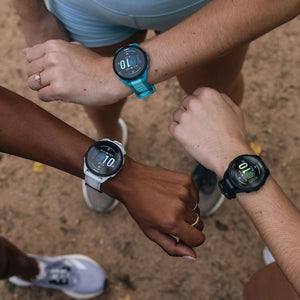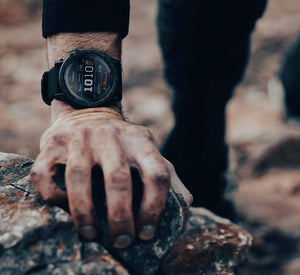
Garmin vivoactive 6 Review: Punched-Up Fitness Prowess
The new Garmin vivoactive 6 packs health, fitness, and training tools into a simple, stylish, smart – and more affordable – package.
At first glance, the new Garmin vivoactive 6 looks like a low-key update. It’s the same size as the vivoactive 5, has the same vibrant AMOLED display, the same simple, lightweight build and battery life. But under the hood, there are some important upgrades that elevate the fitness prowess of Garmin’s entry-level tracker. You get improved GPS, 50 additional sport modes, more comprehensive run-tracking, better customization, an update interface and some new sleep tools.
So is this new Garmin watch now the best budget-friendly tracker you can buy? Read on for the verdict in my Garmin vivoactive 6 review.
Garmin vivoactive 6: An Introduction
The Garmin vivoactive 6 is a sleek, AMOLED-toting multisport smartwatch that goes big on health and fitness tracking, offers an increasingly well-rounded suite of sports training tools and a good package of smartwatch smarts, including offline music and NFC payments.
In Garmin’s fitness-tracker smartwatch line-up, it drops in between the pricier – and more premium – Venu series and the non-GPS vivomove. It now offers more of the run tracking you find on the Garmin Forerunner line-up, too. But if the Forerunner is more about out-and-out sports tracking, the vivoactive 6 shoots for a finer balance between wearability, simple style, smarts and fitness firepower. A kind of turbo-charged everyday tracker.
Garmin vivoactive 6 Design
The Garmin vivoactive 6 screams simplicity and subtle styling. The 1.2-inch AMOLED display uses Gorilla Glass 3.0 and serves up happy smartwatch vibes. Garmin doesn’t list the Nits brightness and in testing it wasn’t quite a match for the Apple Watch SE 2. But it’s still bright enough, sharp and easy to read in most conditions.
The aluminum bezel and a fibre-reinforced casing are pretty standard on watches at this price. It does feel a bit plastic but that helps keep the vivoactive 6 nice and light. It’s now 2mm thinner than its predecessor, and at 23g it’s one of the lightest, most comfortable Garmin GPS watches. For easy 24-7 wearability, it’s excellent.
In addition to the snappy, responsive touchscreen, the vivoactive 6 has two buttons for navigating and control. It’s all easy to use and pretty intuitive.
It’s water related to 50 meters, the same as the Apple Watch SE2 and the Samsung Galaxy Watch 7 but unlike those two, there’s no altimeter. So it’s not as good for hiking or running lumpier mountain trails.
You also don’t get an ECG or skin temperature sensor here.
How I Tested This Garmin Watch
To find out how the Garmin vivoactive 6 performs for comfort, features, accuracy and battery life, I lived with it on my wrist 24-7 for a month. I trained with it, travelled with it, slept with it and put it up against some rival fitness smartwatches like the Amazfit Active 2 and some much pricier and more advanced sports watches, including the Garmin Fenix 8 AMOLED.
I tested the AMOLED screen in all kinds of conditions, delved into the training, recovery, health and navigation features. Analyzed my training data, dug deep into the GPS tracks and used the Garmin HRM Pro+ and HRM 200 chest straps to test the reliability of the optical heart rate.
Models, Sizes & Prices
The Garmin vivoactive 6 comes in one 42mm size and four different colors: Lunar Gold with Bone Band, Slate with Black Band, Metallic Jasper Green with Jasper Green Band, Metallic Pink Dawn with Pink Dawn Band. The 22m bands are also swappable.
At launch, the Garmin vivoactive 6 price was $299.99. That puts it in roughly the same ballpark as the COROS Pace 3 ($229), the Apple Watch SE 2 ($299)
Garmin vivoactive 6 Battery Life
On paper the Garmin vivoactive 6 battery life is listed at 21 hours tracking in regular GPS mode, 17 hours in All Systems GPS mode, falling to 8 hours if you use the music.
You also get up to 11 days in smartwatch mode without the Always On screen or five with the screen always on.
In testing, the Garmin vivoactive 6 battery was impressive for a smaller, AMOLED watch. In total, I got 6 days of general usage with 8.5 hours GPS training before I had to pop it back on charge. That’s significantly better than smartwatches like the Apple Watch SE 2.
On average, with the Always On screen switched off, using the All Systems GPS accuracy mode, an hour’s run burned 6-7%. Meanwhile, a 4.5-hour run burned just short of 25%.
If you extrapolate and take into account the burn rate speeds up when you get towards empty, that comes up around the listed 18 hours.
The Garmin vivoactive 6 battery life headlines:
- A 30-minute run with All Systems GPS burned 3%
- A 1-hour run with All Systems GPS on average burned 6-7%
- A 1-hour run GPS only burned 6%
- The average overnight burn was 2%
Garmin vivoactive 6: Running, Fitness and Health Features
The Garmin vivoactive 6 is gradually becoming a fairly serious training tool. It doesn’t boast all of Garmin’s most advanced training tools and insights, but with more than 80 preloaded sport modes, including running, cycling, swimming, kayaking and pickleball, it’s much more than just a fitness tracker with a fancy display.
Runners now get indoor, trail, and track modes, along with running form insights, running power from the wrist and race-day tools like PacePro.
Swimmers have indoor and outdoor modes. But there’s no triathlon mode to cater for the swim–bike-runners. So multisport watch and triathlon watch hunters will have to pedal, paddle and plod on.
When it comes to training, fitness and activity insights, the vivoactive 6 offers core metrics like activity, steps, estimates VO2 Max and your fitness age. It also offers up daily suggested workouts. However, unlike Suggested Workouts on the Forerunner series, unless you set up a Garmin Coach plan for running and cycling, these are only for walking. And I didn’t find recommendations like “Take a brisk 25 minute walk” told me anything I didn’t already know.
If you want more serious help, you can download workouts for strength training, HIIT, yoga, Pilates, and mobility from Garmin Connect. Additionally, Garmin Coach provides adaptable running, cycling and strength training plans that adjust based on performance and recovery metrics. And those come with handy workout animations.
Health tracking is equally comprehensive, kicking off each day with Garmin’s Morning Report which gathers insights on sleep quality, recovery, overnight heart rate variability and Body Battery level, along with your daily schedule, so you can see how prepared you are for the day ahead.
Throughout the day, you can monitor Body Battery (a loose metric that attempts to estimate your energy levels), stress, blood oxygen and breathing rate. Plus there’s women’s cycle tracking and abnormal heart rate alerts.
Sleep tracking fans get comprehensive slumber tracking and nap detection, along with a sleep coach that recommends how you should adjust your sleep. Though mine regularly recommended I should get less sleep when I was clocking 8.5 hours on average.
Garmin also added a Smart Wake Alarm that taps into your sleep cycle to wake you up at the optimum moment.
Garmin Smartwatch Tools
When it comes to smartwatch tools on sports watches, Garmin still leads the way. Though it lacks the suite of third party apps and tools you enjoy on rival smart watches like the Apple Watch SE 2 and the Samsung Galaxy Watch 7. You also don’t get any of the voice tools offered on the latest Garmin Venu 3 models.
But all the basics are covered and the Garmin vivoactive 6 packs some handy firepower for tackling everyday life: smartphone notifications, weather updates, and calendar alerts, 8GB storage for offline music (doubled from the vivoactive 5) with Spotify and Deezer support, plus contactless payments.
Then vivoactive goes big on safety, too, with Live Track location sharing (with a connected smartphone) and Incident Detection (a bit like Apple's Crash/Fall Detection) that can automatically share your location to emergency contacts if an incident occurs. You can also trigger this manually if you feel unsafe.
Garmin vivoactive 6 Heart Rate and GPS Accuracy
The Garmin vivoactive 6 now offers more GPS systems adding Beidou and QZSS to the list. But like the Garmin Forerunner 165, it still doesn’t offer the more-advanced, accuracy-enhancing multiband that we get on the best running watches or the best Garmin GPS watches.
The optical heart rate sensor remains the same as the vivoactive 5 with Garmin Elevate v4. That means no ECG.
I tested the Garmin vivoactive 6 GPS accuracy and heart rate reliability against a selection of rivals, including the Garmin Forerunner 165, the COROS Pace 3 and the cheaper Amazfit Active 2. I also used a Garmin HRM Pro+ chest strap and the top-tier Garmin Fenix 8 AMOLED as a benchmark.
My test runs were mainly around semi built-up urban streets with some open sky park runs and tree-covered river paths thrown in.
In testing, I was pleasantly surprised by the Garmin vivoactive 6 GPS performance against the pricier (and multiband) Garmin Fenix 8 and Garmin Instinct 3. On total distances, I was always within an ok margin for error. When you dig into the GPS tracks, it’s often as reliable at snapping me to my routes as those other watches.
It wasn’t completely trouble-free but I thought I’d notice much more discrepancy without the multiband on board.
The heart rate was a bit hit and miss. It performed well on steady runs with slower progression, or less jumpy changes in intensity but struggled on intervals. It also struggled a lot in very cold and wet conditions.

Bottom Line: Should You Buy the Garmin vivoactive 6?
The Garmin vivoactive 6 straddles the line between fitness tracker, smartwatch and sports watch. And it does a genuinely good job.
It’s a neat, compact, capable and comfortable AMOLED fitness watch that offers plenty of firepower for general fitness pursuits and tracking daily health. There’s also more here for runners, too. Plus pretty reliable heart rate and GPS, so if you’re looking for a basic run tracker in a wrist-friendly design, it’s got credentials.
If you’re looking for an out and out smartwatch, it lacks the third-party apps and optional cellular connectivity of rivals like the Apple Watch SE 2 and the Samsung Galaxy Watch 7. Those are better life tools.
If your priority is serious training insights, big battery life, nailed-on GPS accuracy and the very latest and best heart rate tracking, you might want to look at the Garmin Forerunner 165 or a COROS Pace 3.
About Journalist Kieran Alger
Co-founder of The Run Testers, Kieran Alger is an experienced journalist who has spent more than a decade testing running gear. Regularly found wearing four GPS running watches at once, if it claims to make you run better or enjoy running more, he has probably tested it. He's a borderline obsessed runner with more than 50 marathon and multiple ultra finishes. In 2022, he became the first person to run Europe's river Danube from sea to source, a measly 1,830 miles in 66 days. And still had time to test running gear.
Check him out on Instagram or his YouTube Channel!
















